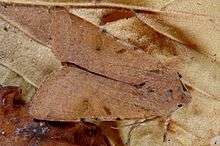Agrochola lychnidis
Agrochola lychnidis, the beaded chestnut, is a moth of the family Noctuidae. It is distributed throughout the whole of Europe from Ireland to the Urals. It also occurs in western North Africa and Asia minor.
| Agrochola lychnidis | |
|---|---|
 | |
| Scientific classification | |
| Kingdom: | |
| Phylum: | |
| Class: | |
| Order: | |
| Family: | |
| Genus: | |
| Species: | A. lychnidis |
| Binomial name | |
| Agrochola lychnidis (Denis & Schiffermüller, 1775) | |
The wingspan is 30–35 mm. Forewing bright rufous or reddish ochreous with the veins paler, often dusted with darker; inner and outer lines double, dark, with the centre rufous, often very faint, but always marked by black spots on costa; submarginal line preceded by a row of dark lunules between the veins and by a dark bar at costa; median shade distinct; stigmata blackish, distinct, especially the narrow oblique orbicular; hindwing dark grey, the fringe rufous. This species varies in colour exceedingly; the brighter rufous specimens, with pale veins, represent typical lychnidis F.; the duller brownish forms, also with pale veins, are pistacina F.; - rubetra Esper the bright rufous unicolorous form with all markings indistinct, and the costal edge often conspicuously white at middle, of which ferrea Haw. is an offshoot, having only the 4 costal blotches and the stigmata dark; the paler, reddish ochreous, unicolorous form is obsoleta Tutt; of the forms without red colouring, serina Esp. has the markings plain, while in pallida Tutt they are obscure, the ground colour being greyish ochreous or yellowish;of the brownish rufous or brownish grey forms, brunnea Tutt is a more sombre form than pistacina without pale nervures; canaria Esp. is a form in which the lines and veins and edges of the stigmata are dull fulvous and the ground colour blackish, as a rule much darker in the male than in the female; dark specimens like these also occur but with the light shades only dull brown and the dark interspaces not so black; caerulescens Calb. from Italy, is a bluish or lilac grey insect; this form also occurs in Asia Minor; a large number of examples from Amasia, especially females, agree exactly, while the rest, mainly males become greyish luteous, as in serina, with the markings varying in intensity".[1]
Biology
The larvae are polyphagous feeding on low plants when small, later consuming the leaves of various trees and shrubs[2] (Prunus, Salix, Achillea, Ranunculus etc.).
The moths fly in September and October.
References
- Seitz, A. Ed., 1914 Die Großschmetterlinge der Erde, Verlag Alfred Kernen, Stuttgart Band 3: Abt. 1, Die Großschmetterlinge des palaearktischen Faunengebietes, Die palaearktischen eulenartigen Nachtfalter, 1914
- "Robinson, G. S., P. R. Ackery, I. J. Kitching, G. W. Beccaloni & L. M. Hernández, 2010. HOSTS - A Database of the World's Lepidopteran Hostplants. Natural History Museum, London".
External links
| Wikimedia Commons has media related to Agrochola lychnidis. |
- Beaded chestnut on UKmoths
- Funet Taxonomy
- Lepidoptera and their ecology
- Fauna Europaea
- Lepiforum.de
- Vlindernet.nl (in Dutch)